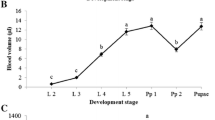Summary
In the hemolymph of Golfingia gouldi occur three types of cells: Prohemocytes, erythrocytes and leucocytes. The prohemocytes spring from proliferating peritoneal cells and possess cilia at an early stage of their development. The majority of the mitochondria have their outer membrane in direct contact with the outer nuclear membrane. The ultrastructure of erythrocytes is similar to that of lower vertebrates. The mitochondria, endoplasmic reticulum and Golgi-complex are degenerated. Often one finds clusters of a ferritin-like substance. The cell membrane is definitely three-layered. On its inner side there are electron-opaque particles aligned in a row. The function of erythrocytes in oxygen storage is discussed. The leucocytes contain electron-opaque granules surrounded by a membrane and “multivesicular bodies” and are highly variable in their shape.
Zusammenfassung
In der Haemolymphe von Golfingia gouldi kommen drei Zelltypen vor: Prohaemocyten verschiedener Reife, Erythrocyten und Leukocyten. Die Prohaemocyten entstehen aus proliferierten Peritonealzellen und tragen in frühen Stadien noch Kinocilien. Die Mehrheit ihrer Mitochondrien liegt unmittelbar an der äußeren Kernmembran. Die Ultrastruktur der Erythrocyten ähnelt jener der roten Blutzellen niederer Wirbeltiere. Mitochondrien, endoplasmatisches Retikulum und Golgi-Apparat sind zurückgebildet oder fehlen. Häufig kommen siderosomenähnliche Komplexe im Cytoplasma vor. Die Zellmembran ist deutlich dreischichtig und dicker als gewöhnlich. An ihrer Innenseite sind elektronendichte Körnchen aufgereiht. Die Funktion der Erythrocyten als Sauerstoffspeicher wird diskutiert. Die Leukocyten enthalten elektronendichte Granula, „multivesicular bodies“, und sind sehr variabel in der Form.
Similar content being viewed by others
Literatur
Awati, P., Predham, L.: Anatomy of Dendrostoma signifer. J. Univ. Bombay 3, V, 4–45 (1934).
Fänge, R., Åkesson, B.: The cells of the coelomic fluid of Priapulides and their content of haemerythrin. Årkiv Zool. 3, 25–31 (1951).
Florkin, M.: Review of respiratory functions of body fluids. Ann. Physiol. 10, 599–694 (1934).
Harms, W.: Morphologische und causalanalytische Untersuchungen über die Internephridialorgane von Physcosoma lucro. Arch. Entwickl.-Mech. Org. 47, 307–374 (1921).
—: Sipunculiden. In: Handwörterbuch der Naturwissenschaften, Bd. 9, S. 85–100. Jena: G. Fischer 1934.
—, Dragendorff, O.: Osmotische Untersuchungen an Physcosoma lurco. Z. wiss. Zool. 143, 263–322 (1933).
Hyman, L. H.: The invertebrates, vol. 5. New York: McGraw-Hill 1959.
Kawaguti, S.: Haemerythrin found in Lingula. Mem. Fac. Sci. Agric. Taihoku 23, 12–25 (1941).
Manwell, C.: O2-equilibrium of Phascolosoma and Lingula hemerythrins. Science 127, 592–593 (1958).
—: Histological specifity of respiratory pigments. Comp. Biochem. Physiol. 1, 267–285 (1960).
—: O2-equilibrium of Phascolosoma and Lingula hemerythrins. Science 132, 550–551 (1960).
—: Respiratory pigments. Ann. Rev. Physiol. 22, 191–244 (1960).
Ohuye, T.: On the blood corpuscles and the hemopoiesis of a Nemertean, Linens fuscoviridis, and of a Sipunculus, Dendrostoma minor. Sci. Rep. Tohoku Imp. Univ., Ser. IV, Biol. 17, 187–196 (1942).
Prosser, C. L., Brown, F. A.: Comparative animal physiology, 2nd ed. Philadelphia: Sounders 1965.
Redfield, A. C., Florkin, A. M.: Respiratory function of blood of Urechis caupo. Biol. Bull. 61, 185–210 (1931).
Reynolds, E. S.: The use of lead citrate at high pH as an electron-opaque stain in electron microscopy. J. Cell Biol. 17, 208–211 (1963).
Stobbe, H., David, H.: Zellstruktur kernhaltiger roter Blutkörperchen niederer Wirbeltiere. Folia haemat. 83, 102–117 (1965).
Winterstein, H.: Zur Kenntnis der Blutgase wirbelloser Seetiere. Biochem. Z. 19, 384–424 (1909).
Author information
Authors and Affiliations
Additional information
Herrn Prof. Dr. med. J. Staubesand danke ich für wertvolle Hinweise und Kritik.
Rights and permissions
About this article
Cite this article
Stang-Voss, C. Zur Ultrastruktur der Blutzellen wirbelloser Tiere. Z. Zellforsch. 106, 200–208 (1970). https://doi.org/10.1007/BF00335738
Received:
Issue Date:
DOI: https://doi.org/10.1007/BF00335738




